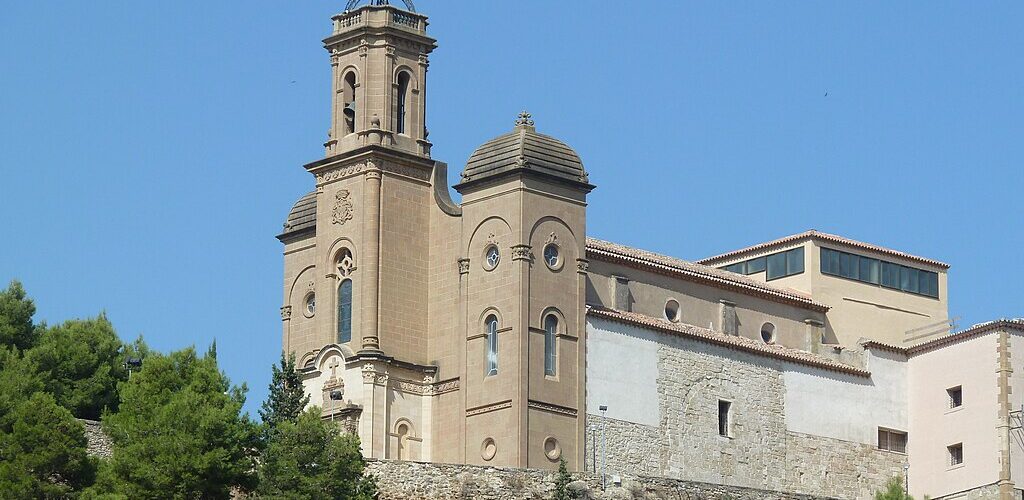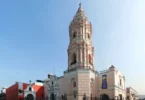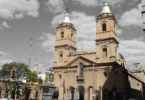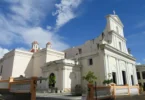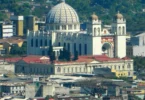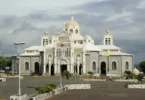Introduction
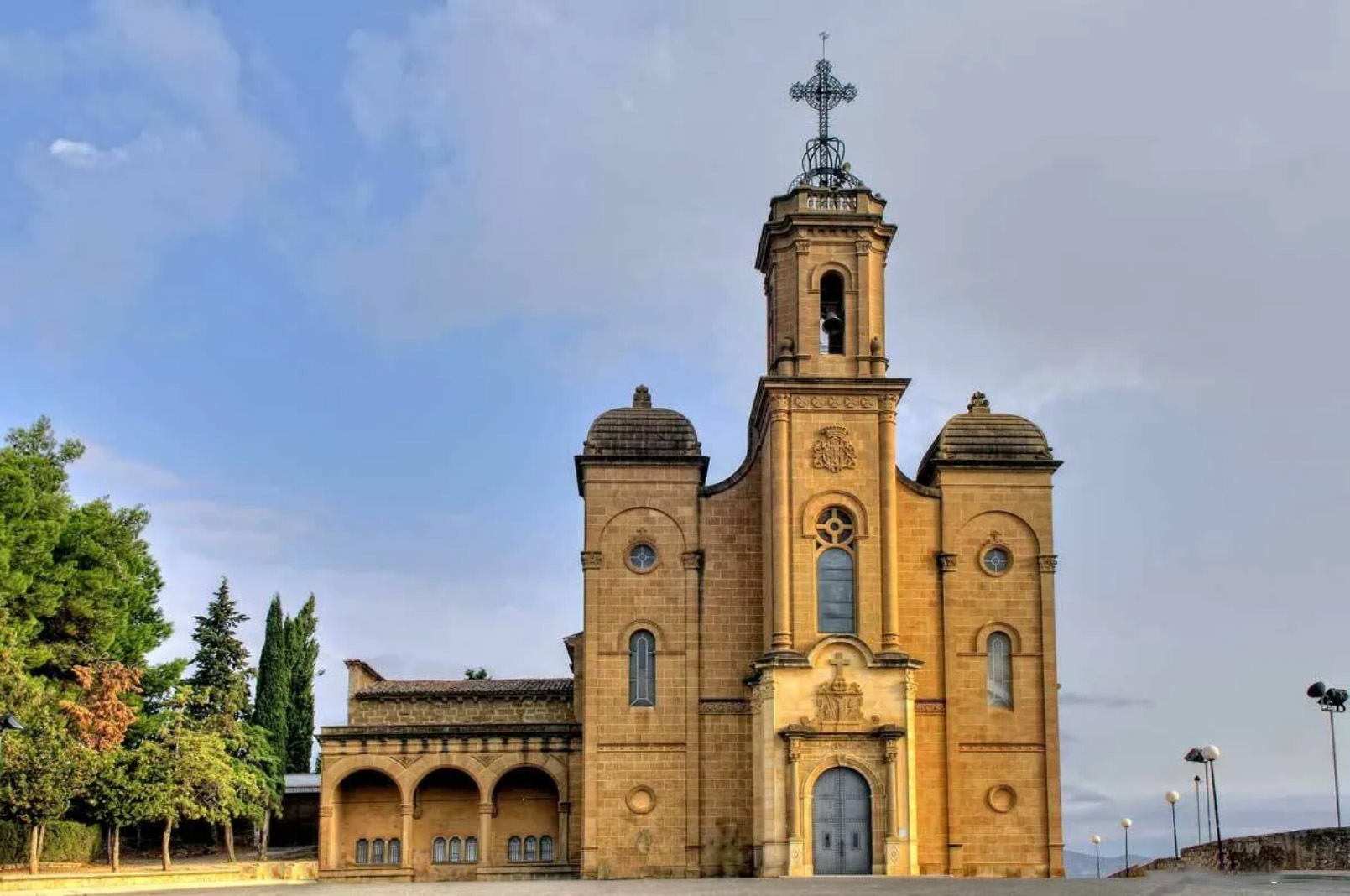
The Sant Crist de Balaguer, Sanctuary of the Holy Christ is a church in the municipality of Balaguer (province of Lleida , Spain), is a sanctuary and basilica located in the Pla d’Almatà de Balaguer.The protected as a cultural asset of local interest. The church was built in the 17th century on the same site where there had been a Romanesque church, and even before that a mosque. The building is a property of cultural interest, and has a modern 20th century facade in neoclassical style , built under the direction of the architect Bernat Pejoan i Santmartí. The Basilica of the Holy Christ of Balaguer , located in the heart of Balaguer, Catalonia , is a jewel of historical value and religious devotion. Rising from the highest point of the city, it offers panoramic views that amaze all its visitors. Its history dates back to Muslim times, having been the main mosque and later a convent of Poor Clares. The venerated image of Christ, the central motif of the basilica, attracts numerous devotees. Declared a minor basilica in 2016 by Pope Francis, it is a sanctuary of peace that offers moments of spirituality and reflection.
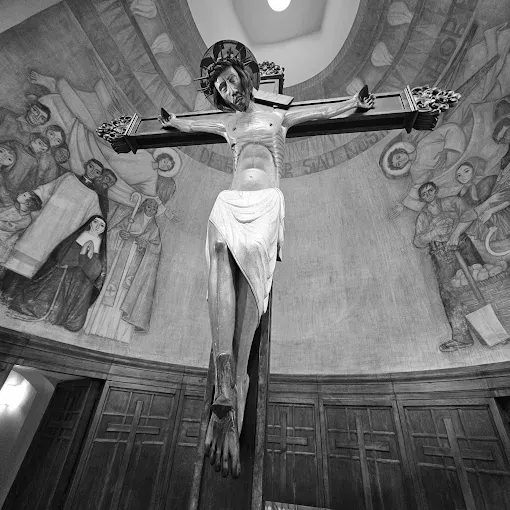
Background
Before the Christian conquest, Balaguer had three neighborhoods: the Almatà neighborhood (in the Pla d’Almatà ), the Pla del Reial, and the river neighborhood. Each neighborhood had its own mosque, but the largest or also called aljama was that of Sant Miquel. When the city was conquered, each mosque became a church. That of Sant Miquel became Santa Maria d’Almatà, the immediate predecessor of this church, which was not called Sant Crist until the 16th century. The Pla d’Almatà was settled by the Arabs at the beginning of the 8th century. It was the original nucleus of the city and one of its main neighborhoods, surrounded by a wall. The mosque was located approximately where the church of Sant Crist is currently located. The Pla d’Almatà is one of the largest Andalusian-era sites preserved in Catalonia and declared a Cultural Asset of National Interest in 2006.
At the same time, it is recorded that in 1094, after a temporary conquest of Balaguer (the definitive one would not arrive until 1105), Ermengol V of Urgell donated to Sant Serni de Tavèrnoles the properties of an important character of Balaguer called Avimoni, among which was a mosque. On the Avimoni mosque, the church of Sant Salvador was built, of which there is news since 1163. Later, in 1351, this church acquired the category of parish church to the detriment of Santa Maria d’Almatà . The temple began to be called Sant Crist when, on March 22, 1622, in the presence of King Philip IV and his brother Carlos, Count of Olivares, and other Great People of the Nation, the image of the Blessed Sacrament was transferred from the old chapel to the high altar that had just been built for this purpose, from that moment on, the Virgin of Almatà ceased to be the titular deity of the church. At the end of the 18th century, the continuous increase in visitors led to the creation of the chapel and the expansion of the temple, which came to have its current dimensions. The Sanctuary of the Holy Christ and the convent are the focus of a significant devotional movement that comes to visit the image of Christ. Thanks to royal favors and popular alms, it has experienced moments of splendor throughout history, alternating with periods of decline. The Sanctuary was declared a minor Basilica on 9 May 2016 by Pope Francis.
Architecture of Basilica of the Holy Christ of Balaguer, Balaguer, Spain
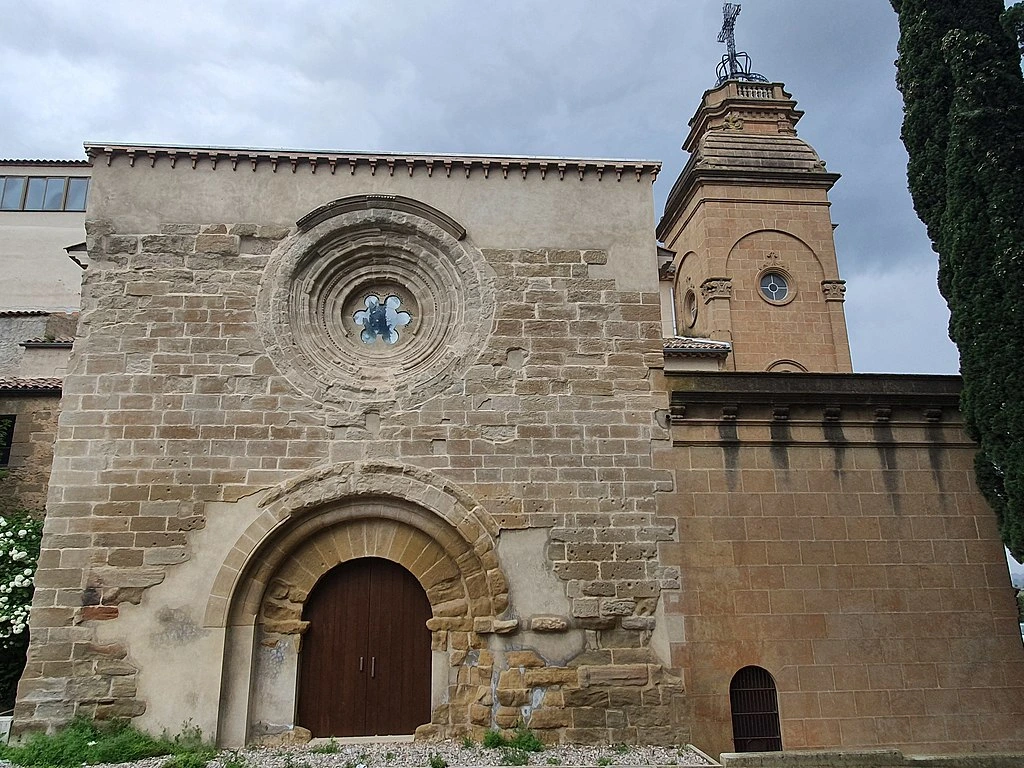
Architectural style : Baroque Architecture.
The Romanesque Church, architecture
At the old entrance door there is a Romanesque door with many details from the Escola de Lleida, with a large rose window and without a tympanum, very deteriorated and later restored. The restoration of the facade was possible thanks to the collaboration of the Center for the Restoration of Moveable Property of the Generalitat de Catalunya. Originally the church had a single nave, Romanesque and oriented to the East, covered with barrel vaults and topped with a semicircular apse. On the door there are remains of shrapnel impacts from the Civil War.
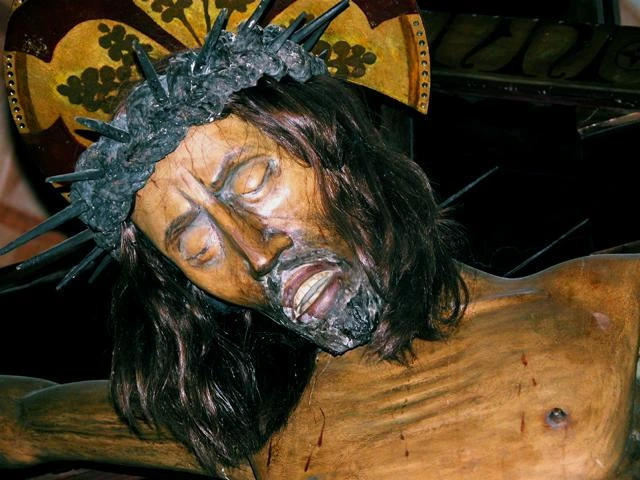
Convent of the Poor Clares and Hostage of the Holy Christ
Around 1351 the counts of Urgell – in this case James I of Urgell – decided to give the church to the Franciscan community so that they could establish and found a convent for 13 nuns, the convent of the Poor Clares. This convent has an anecdote and it is that the Franciscans were the ones who would bring the cult of the crucifix to Catalonia and Aragon. Originally the church was dedicated to the Virgin Mary “Santa Maria d’Almatà”. At a certain point, a Saint Christ was added to one of the side chapels, which was not originally the first and most venerated image, but would be just one more image. The Poor Clares give meaning to Saint Clare who is the female branch of Saint Francis, who would be the Franciscans. Saint Clare has the charism of Poverty and Prayer.
In the 16th century there was so much worship of the image of the Holy Christ, that when so many people came it became a Sanctuary. It was a church where there was a lot of devotion to an image and it was decided to expand the church, and what they did was to “turn it around” that is, you enter through what is now the main door, and the old church is integrated as if it were just a side chapel, this was a great transformation. Later this church was expanded and we find the church we have now from the 20th century, therefore the facade we observe today is a noucentista facade . The community of Poor Clares of Balaguer continued, but from the Council of Trent, they would create many difficulties for the female communities. From that moment on, there began to be few nuns, so it had to be refounded, so we find a tombstone from 1622, it is a baroque tombstone due to the typography, it speaks of how on “March 21, 1622, people from a community of Poor Clares from a bay in Tarragona came to the city of Balaguer to refound the community here.”
We found a Baroque door , which was the entrance door to the convent once it was refounded, the tombstone and the door were made at the same time and were made by the bishopric. We find another door that gave onto the Hospice, apart from the community of nuns there had been a type of pilgrim hostel, so this spectacular door is an inn, on the door itself we find a coat of arms that is from the city of Balaguer, it is a door more towards the Renaissance or early Baroque, very symmetrical, very neoclassical, we find horror vacui on the door and the vegetal decorations. Next to this building, we find another Baroque building, topped by a tympanum and all square windows, that was the bishop’s house, when the bishops of Urgell came to Balaguer they stayed here. Currently this inn is called Hotel Santuari. All this shows that it was a place of great pilgrimage and a place of attraction for the faithful.
Devotion to the Holy Christ in the lands of Urgell
The church of Sant Crist and the convent are a magnet and receiving center for a prominent movement of devotion that flocks to visit the Holy Image. Thanks to royal favors and popular alms, it has experienced moments of splendor throughout history, alternating with periods of decline. The Sanctuary is dedicated to the image of Saint Christ, its main invocation, patron saint of Balaguer and the Terres d’Urgell, although its influence extends beyond the Ponent and Pyrenees Counties to other lands in Catalonia and Aragon. The Gothic image of Santa Maria d’Almatà is also venerated in the Sanctuary, although in a more accurate form, we find a carving of the image seen from afar from the bars of the convent of the Poor Clares that overlook the church, this image was invoked by the Counts of Urgell during the reconquest, it is said that they carried it on the saddle of their horse.
From the Sant Crist de Balaguer we can see the entire plain of Urgell, traditionally the Sant Crist has been one of the co-patrons of the Plana d’Urgell , there are two co-patrons The Sant Crist de Balaguer, and the Mare de Déu de les Sogues de Bellvís . Therefore, in the plain of Urgell from the 18th , 19th to the 20th century many songs and many joys that spoke of the Mare de Déu de les Sogues and Sant Crist de Balaguer became fashionable , “if you want me to become a monk, let me get married first” for example. During these centuries, most parishes in the area of the Urgell plain that are closest to Balaguer, from Fuliola and from Linyola towards Balaguer, were suffragan of Sant Crist, and had to pay taxes.
Motive of inspiration for artists
At the end of the 19th century , a hymn dedicated to the Holy Christ was written with lyrics by Jacint Verdaguer and music by the Balaguer composer and priest Josep Sorribes i Ruiz del Castillo (1838–1906). The Ode “Hymne a la Romeria” has become a hymn of the city of Balaguer in the context of the Renaixença . His victory on the Cross is sung in vibrant verse by the great poet of the renaissance of the Catalan language, with very inspired music by Mestre Sorribes. He proclaims with faith: “From the blue sky by the shortcut, be our vanguard; be our banner, Sant Cristo de Balaguer”.
Basilica and Sanctuary
So, the Church of Sant Crist got made a Basilica in 2016. If you go inside and look to the right near the fifth chapel that’s the reception chapel there’s a plaque. It says that on May 9, 2016, Pope Francis officially gave this church the title of Minor Basilica. It was signed off by Cardinal Robert Sarah. Then, on November 9, 2016, which also happens to be the feast day of Sant Crist, they had a big ceremony led by the Bishop of Urgell, Joan-Enric Vives, to celebrate it. The Catholic Church divides churches into five types. At the top is the Roman Catholic Church itself. Then there are the four major basilicas in Rome. After that come all the cathedrals worldwide, then the minor basilicas like this one, and finally the rest of the churches. When you enter Sant Crist, you’ll see this canopy thing that shows you’re inside a basilica. Also, in the Diocese of Urgell, there are four other minor basilicas: the Cathedral of Santa Maria in La Seu d’Urgell, the Parish of Santa Maria de Valldeflors in Tremp, the Sanctuary of Our Lady of Núria, and the Sanctuary of Our Lady of Meritxell.
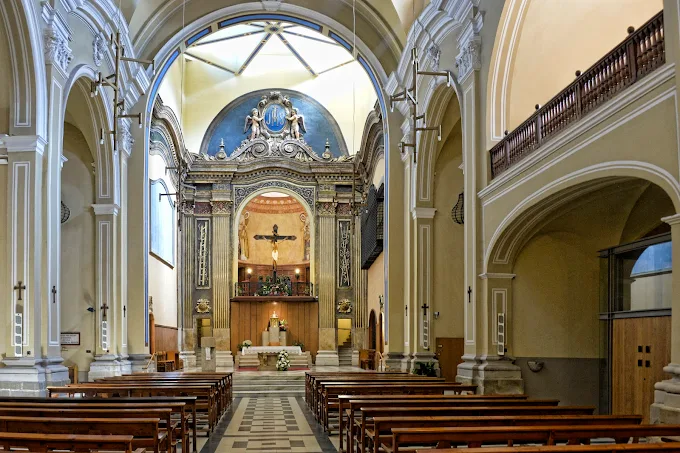
Inside the Church
Inside, the church is big and wide with one main space called a nave and some side chapels. The ceiling is vaulted and decorated in baroque style. Behind the main altar, stairs lead up to the statue of the Holy Christ. The one there now is a copy made in 1947 because the original Gothic statue was lost during the Civil War. Only the foot of the original survived, and they attached it to the new one. You can also see some old pieces from the Almatà church in one chapel. There’s a Gothic door in the Fonda Chapel it’s one of the only parts left from the old church, besides the Romanesque entrance door. The church is split into different sections like the main entrance, the nave, the presbytery (that’s the altar area), the Cambril of St. Christ, a welcome chapel, secondary entrances, the chapel of mercy, the choir area for the nuns, the sacristy, the chapel of St. Francis and St. Clare, and a few more.
Right next to the altar is the Lower Choir where the Poor Clares nuns used to be. They were cloistered, so they sat behind bars and watched the Mass from there without leaving the convent. In that choir area, there’s a little niche with a statue of the Virgin Mary of Santa Maria d’Almatà. She’s different from usual statues she’s not standing straight because she was made to be carried on horseback during processions. In the Chapel of the Piety, there’s a wooden carving showing Jesus taken down from the cross, held by his mother. It was made by monks from the Bethléem Monasteries. There are also some old bronze lamps hanging around in the side chapels.
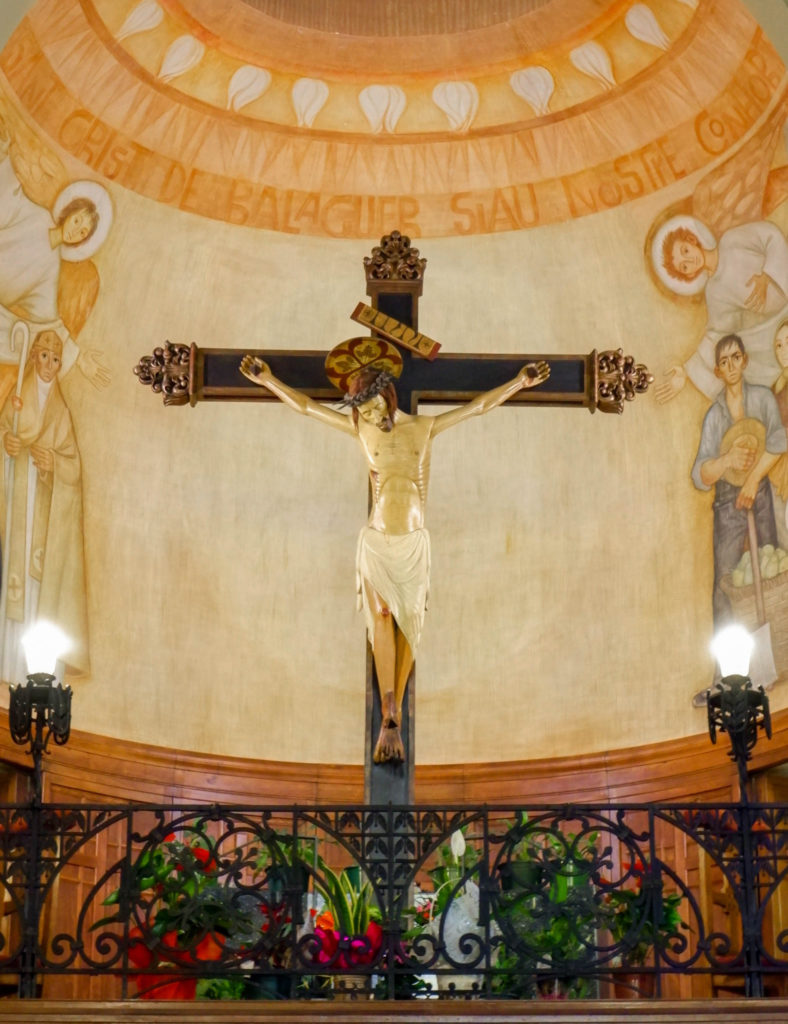
Cambril of St. Christ
This is the raised area behind the altar where the statue sits. People go up one side and come down the other.There are two paintings here by Llucià Navarro, an artist from the 60s who made drawings for kids. He was religious but also used his art to quietly criticize Franco’s regime by showing workers, farmers, and everyday folks in his paintings. Behind the altar, on the stairs people come down, there’s a relic one of the nails believed to be from Jesus’ crucifixion. There’s even a document from Rome proving it’s real. In the 1980s, they made the church brighter by adding windows, and updated the columns and the altarpiece behind the altar, which is baroque but also has some neoclassical style.
Outside the Church
The outside looks clean and classical, inspired by Roman design. It has a big arch and two Corinthian columns making it look elegant.
Legend of the Holy Christ of Balaguer
Nicodemus, a follower of Jesus and a sculptor, was there at the crucifixion. He wanted to carve a statue showing the pain he saw but couldn’t get the face right. One night, he dreamed angels came and finished it for him. This statue is one of a few called “Christs of Nicodemus” in Europe. The original was first in the Holy Land, then moved to Beirut. During Ottoman attacks, it was thrown into a river but floated all the way to Balaguer on the Segre River. People tried to take it from the river but it wouldn’t move. The next day, the cloistered nuns were called. When the Mother Abbess knelt by the river, the statue floated into her arms. The whole town followed her to the church, and the statue has stayed there ever since.
Feast Day
Feast Day : 09 November
The feast day of the Basilica of the Holy Christ of Balaguer is celebrated every year on November 9. This is also the main festival of Balaguer, honoring Sant Crist, the city’s patron and a figure of deep devotion across the Urgell region.
Church Mass Timing
Monday to Saturday : 09:00 AM , 8:00 PM
Sunday : 09:00 AM, 11:30 AM, 1:00 PM, 8:00 PM,
Church Opening Time:
Monday to Saturday : 09:00 AM.
Sunday : 10:00 AM.
Contact Info
Address : Saint Christ of Balaguer
Carrer Pla d’Almata, s/n, 25600 Balaguer, Lleida, Spain.
Phone : +34 973 44 53 35
Accommodations
Connectivities
Airway
Basilica of the Holy Christ of Balaguer, Spain, to Lleida-Alguaire Airport, distance 29 min (40.4 km) via C-12.
Railway
Basilica of the Holy Christ of Balaguer, Spain, to Balaguer Railway Station, distance between 6 min (4.7 km) via C-12.

